The NVIDIA GeForce GTX 980 Review: Maxwell Mark 2
by Ryan Smith on September 18, 2014 10:30 PM ESTOverclocking GTX 980
One of GTX 750 Ti’s more remarkable features was its overclocking headroom. GM107 could overclock so well that upon initial release, NVIDIA did not program in enough overclocking headroom in their drivers to allow for many GTX 750 Ti cards to be overclocked to their true limits. This is a legacy we would be glad to see repeated for GTX 980, and is a legacy we are going to put to the test.
As with NVIDIA’s Kepler cards, NVIDIA’s Maxwell cards are subject to NVIDIA’s stringent power and voltage limitations. Overvolting is limited to NVIDIA’s built in overvoltage function, which isn’t so much a voltage control as it is the ability to unlock 1-2 more boost bins and their associated voltages. Meanwhile TDP controls are limited to whatever value NVIDIA believes is safe for that model card, which can vary depending on its GPU and its power delivery design.
For GTX 980 we have a 125% TDP limit, meanwhile we are able to overvolt by 1 boost bin to 1265MHz, which utilizes a voltage of 1.25v.
| GeForce GTX 980 Overclocking | ||||
| Stock | Overclocked | |||
| Core Clock | 1126MHz | 1377MHz | ||
| Boost Clock | 1216MHz | 1466MHz | ||
| Max Boost Clock | 1265MHz | 1515MHz | ||
| Memory Clock | 7GHz | 7.8GHz | ||
| Max Voltage | 1.25v | 1.25v | ||
GTX 980 does not let us down, and like its lower end Maxwell 1 based counterpart the GTX 980 turns in an overclocking performance just short of absurd. Even without real voltage controls we were able to push another 250MHz (22%) out of our GM204 GPU, resulting in an overclocked base clock of 1377MHz and more amazingly an overclocked maximum boost clock of 1515MHz. That makes this the first NVIDIA card we have tested to surpass both 1.4GHz and 1.5GHz, all in one fell swoop.
This also leaves us wondering just how much farther GM204 could overclock if we were able to truly overvolt it. At 1.25v I’m not sure too much more voltage is good for the GPU in the long term – that’s already quite a bit of voltage for a TSMC 28nm process – but I suspect there is some untapped headroom left in the GPU at higher voltages.
Memory overclocking on the other hand doesn’t end up being quite as extreme, but we’ve known from the start that at 7GHz for the stock memory clock, we were already pushing the limits for GDDR5 and NVIDIA’s memory controllers. Still, we were able to work another 800MHz (11%) out of the memory subsystem, for a final memory clock of 7.8GHz.
Before we go to our full results, in light of GTX 980’s relatively narrow memory bus and NVIDIA’s color compression improvements, we quickly broke apart our core and memory overclock testing in order to test each separately. This is to see which overclock has more effect: the core overclock or the memory overclock. One would presume that the memory overclock is the more important given the narrow memory bus, but as it turns out that is not necessarily the case.
| GeForce GTX 980 Overclocking Performance | |||||
| Core (+22%) | Memroy (+11%) | Combined | |||
| Metro: LL |
+15%
|
+4%
|
+20%
|
||
| CoH2 |
+19%
|
+5%
|
+20%
|
||
| Bioshock |
+9%
|
+4%
|
+15%
|
||
| Battlefield 4 |
+10%
|
+6%
|
+17%
|
||
| Crysis 3 |
+12%
|
+5%
|
+15%
|
||
| TW: Rome 2 |
+16%
|
+7%
|
+20%
|
||
| Thief |
+12%
|
+6%
|
+16%
|
||
While the core overclock is greater overall to begin with, what we’re also seeing is that the performance gains relative to the size of the overclock consistently favor the core overclock to the memory overclock. With a handful of exceptions our 11% memory overclock is netting us less than a 6% increase in performance. Meanwhile our 22% core overclock is netting us a 12% increase or more. This despite the fact that when it comes to core overclocking, the GTX 980 is TDP limited; in many of these games it could clock higher if the TDP budget was large enough to accommodate higher sustained clockspeeds.
Memory overclocking is still effective, and it’s clear that GTX 980 spends some of its time memory bandwidth bottlenecked (otherwise we wouldn’t be seeing even these performance gains), but it’s simply not as effective as core overclocking. And since we have more core headroom than memory headroom in the first place, it’s a double win for core overclocking.

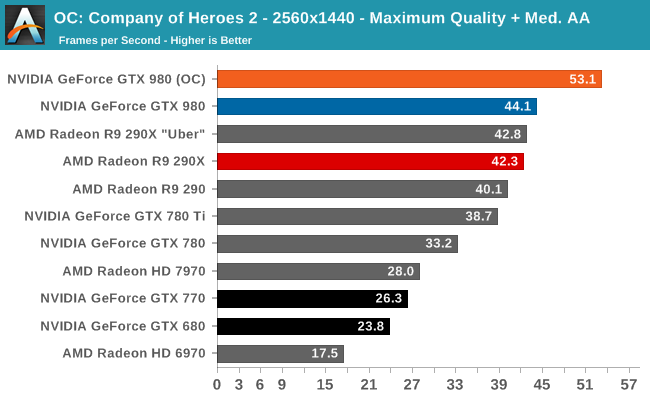
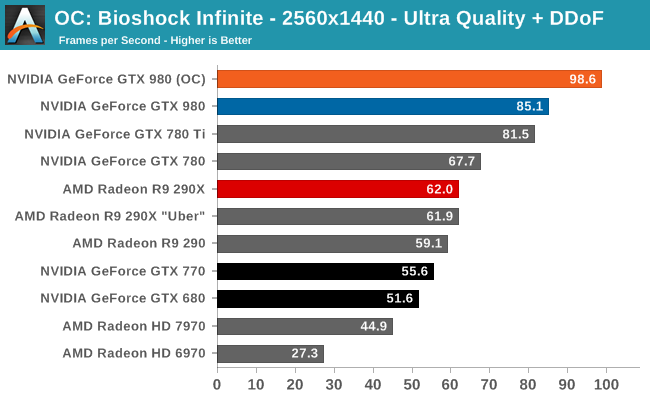
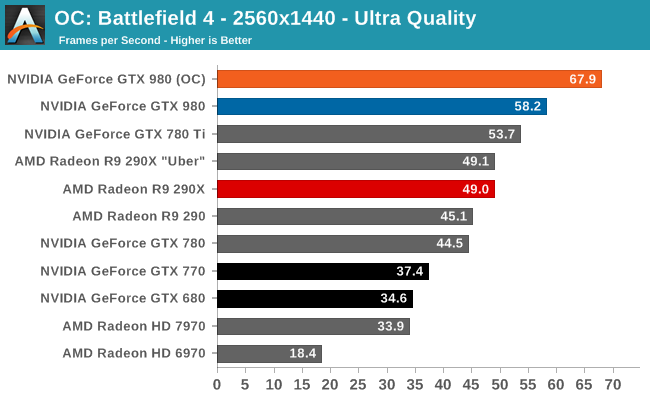
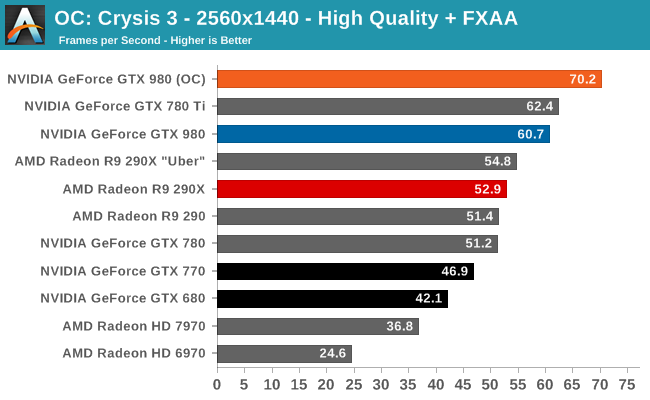
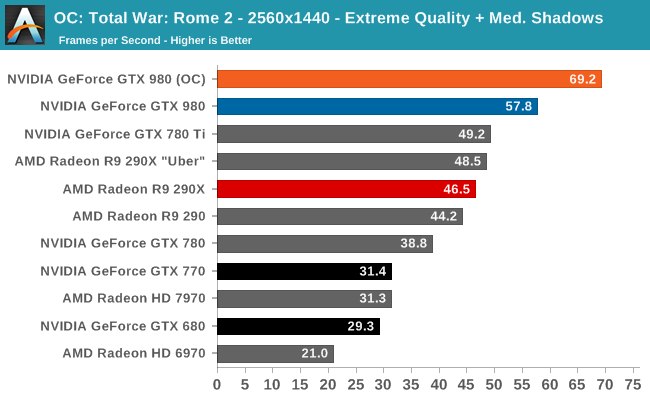
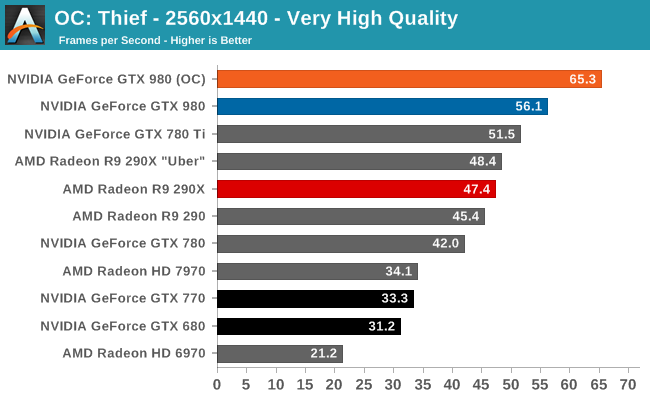
To put it simply, the GTX 980 was already topping the charts. Now with overclocking it’s another 15-20% faster yet. With this overclock factored in the GTX 980 is routinely 2x faster than the GTX 680, if not slightly more.
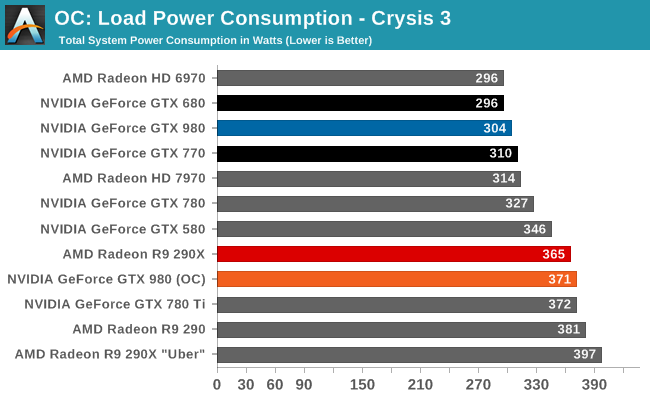
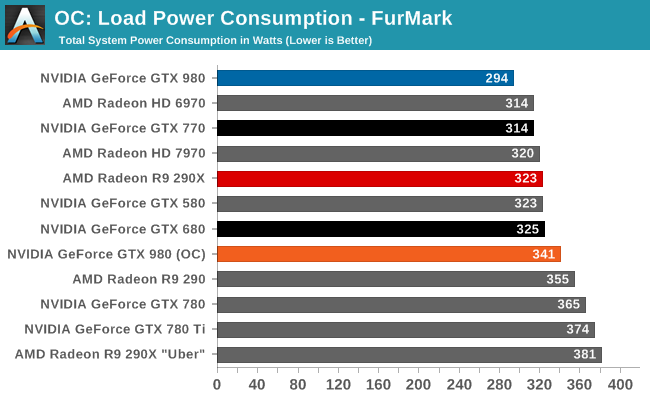
But you do pay for the overclock when it comes to power consumption. NVIDIA allows you to increase the TDP by 25%, and to hit these performance numbers you are going to need every bit of that. So what was once a 165W card is now a 205W card.


Even though overclocking involves raising the temperature limit to 91C, NVIDIA's fan curve naturally tops out at 84C. So even in the case of overclocking the GTX 980 isn't going to reach temperatures higher than the mid-80s.
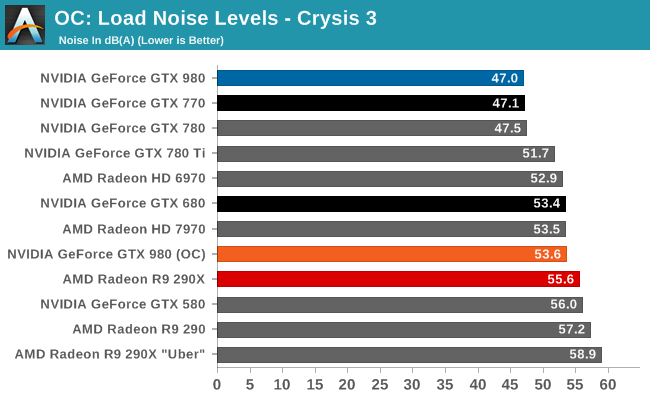

The noise penalty for overclocking is also pretty stiff. Since we're otherwise TDP limited, all of our workloads top out at 53.6dB, some 6.6dB higher than stock. In the big picture this means the overclocked GTX 980 is still in the middl of the pack, but it is noticably louder than before and louder than a few of NVIDIA's other cards. However interestingly enough it's no worse than the original stock GTX 680 at Crysis 3, and still better than said GTX 680 under FurMark. It's also still quieter than the stock Radeon R9 290X, not to mention the louder yet uber mode.










274 Comments
View All Comments
squngy - Wednesday, November 19, 2014 - link
It is explained in the article.Because GTX980 makes so many more frames the CPU is worked a lot harder. The W in those charts are for the whole system so when the CPU uses more power it makes it harder to directly compare GPUs
galta - Friday, September 19, 2014 - link
The simple fact is that a GPU more powerful than a GTX 980 does not make sense right now, no matter how much we would love to see it.See, most folks are still gaming @ 1080, some of us are moving up to 1440. Under this scenarios, a GTX 980 is more than enough, even if quality settings are maxed out. Early reviews show that it can even handle 4K with moderate settings, and we should expect further performance gains as drivers improve.
Maybe in a year or two, when 4K monitors become more relevant, a more powerful GPU would make sense. Now they simply don't.
For the moment, nVidia's movement is smart and commendable: power efficiency!
I mean, such a powerful card at only 165W! If you are crazy/wealthy enough to have two of them in SLI, you can cut your power demand by 170W, with following gains in temps and/or noise, and and less expensive PSU, if you're building from scratch.
In the end, are these new cards great? Of course they are!
Does it make sense to up-grade right now? Only if you running a 5xx or 6xx series card, or if your demands have increased dramatically (multi-monitor set-up, higher res. etc.).
Margalus - Friday, September 19, 2014 - link
A more powerful gpu does make sense. Some people like to play their games with triple monitors, or more. A single gpu that could play at 7680x1440 with all settings maxed out would be nice.galta - Saturday, September 20, 2014 - link
How many of us demand such power? The ones who really do can go SLI and OC the cards.nVidia would be spending billions for a card that would sell thousands. As I said: we would love the card, but still no sense
Again, I would love to see it, but in the forseeable future, I won't need it. Happier with noise, power and heat efficiency.
Da W - Monday, September 22, 2014 - link
Here's one that demands such power. I play 3600*1920 using 3 screens, almost 4k, 1/3 the budget, and still useful for, you know, working.Don't want sli/crossfire. Don't want a space heater either.
bebimbap - Saturday, September 20, 2014 - link
gaming at 1080@144 or 1080 with min fps of 120 for ulmb is no joke when it comes to gpu requirement. Most modern games max at 80-90fps on a OC'd gtx670 you need at least an OC'd gtx770-780. I'd recommend 780ti. and though a 24" 1080 might seem "small" you only have so much focus. You can't focus on periphery vision you'd have to move your eyes to focus on another piece of the screen. the 24"-27" size seems perfect so you don't have to move your eyes/head much or at all.the next step is 1440@144 or min fps of 120 which requires more gpu than @ 4k60. as 1440 is about 2x 1080 you'd need a gpu 2x as powerful. so you can see why nvidia must put out a powerful card at a moderate price point. They need it for their 144hz gsync tech and 3dvision
imo the ppi race isn't as beneficial as higher refresh rate. For TVs manufacturers are playing this game of misinformation so consumers get the short end of the stick, but having a monitor running at 144hz is a world of difference compared to 60hz for me. you can tell just from the mouse cursor moving across the screen. As I age I realize every day that my eyes will never be as good as yesterday, and knowing that I'd take a 27" 1440p @ 144hz any day over a 28" 5k @ 60hz.
Laststop311 - Sunday, September 21, 2014 - link
Well it all depends on viewing distance. I use a 30" 2560x1600 dell u3014 to game on currently since it's larger i can sit further away and still have just as good of an experience as a 24 or 27 thats closer. So you can't just say larger monitors mean you can;t focus on it all cause you can just at a further distance.theuglyman0war - Monday, September 22, 2014 - link
The power of the newest technology is and has always been an illusion because the creation of games will always be an exercise in "compromise". Even a game like WOW that isn't crippled by console consideration is created by the lowest common denominator demographic in the PC hardware population. In other words... ( if u buy it they will make it vs. if they make it I will upgrade ). Besides the unlimited reach of an openworld's "possible" textures and vtx counts."Some" artists are of the opinion that more hardware power would result in a less aggressive graphic budget! ( when the time spent wrangling a synced normal mapped representation of a high resolution sculpt or tracking seam problems in lightmapped approximations of complex illumination with long bake times can take longer than simply using that original complexity ). The compromise can take more time then if we had hardware that could keep up with an artists imagination.
In which case I gotta wonder about the imagination of the end user that really believes his hardware is the end to any graphics progress?
ppi - Friday, September 19, 2014 - link
On desktop, all AMD needs to do is to lower price and perhaps release OC'd 290X to match 980 performance. It will reduce their margins, but they won't be irrelevant on the market, like in CPUs vs Intel (where AMD's most powerful beasts barely touch Intel's low-end, apart from some specific multi-threaded cases)Why so simple? On desktop:
- Performance is still #1 factor - if you offer more per your $, you win
- Noise can be easily resolved via open air coolers
- Power consumption is not such a big deal
So ... if AMD card at a given price is as fast as Maxwell, then they are clearly worse choice. But if they are faster?
In mobile, however, they are screwed big way, unless they have something REAL good in their sleeve (looking at Tonga, I do not think they do, as I am convinced AMD intends to pull off another HD5870 (i.e. be on the new process node first), but it apparently did not work this time around.)
Friendly0Fire - Friday, September 19, 2014 - link
The 290X already is effectively an overclocked 290 though. I'm not sure they'd be able to crank up power consumption reliably without running into heat dissipation or power draw limits.Also, they'd have to invest in making a good reference cooler.